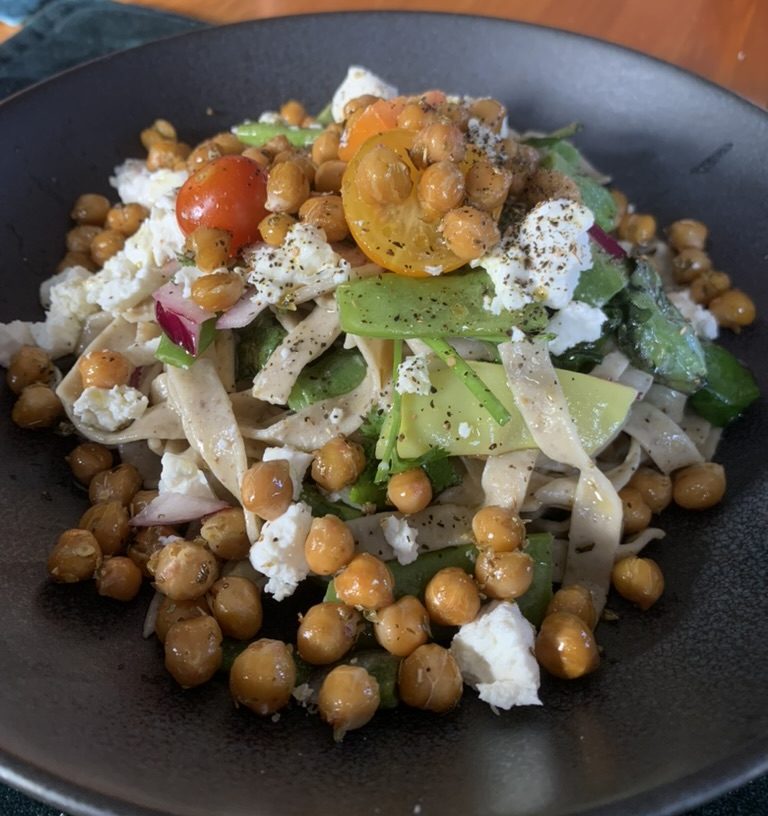author
Jacques Lawinski
post
- 25/01/2023
- No Comments
- Food
share
A delicious way to include home-grown green beans if you’ve got too many, and a perfect pasta salad for a warm lunchtime or dinner meal together.

Ingredients
Serves 4-6
Spelt pasta:
3 cups of white spelt flour
1/4 cup pumpkin seed flour (can omit if you don’t have it)
1 tbsp chia seed flour
cold water
Sauce:
1/4 cup extra virgin olive oil
4 cloves of garlic, sliced
1/2 large red onion
3/4 tin chickpeas, drained and washed
handful of fresh basil leaves
handful of coriander leaves
two handfuls of green beans
2 tbsp lime juice (add more if you like this lime flavour!)
salt and pepper to taste
optional: feta cheese or parmesan, cherry tomatoes on top
Method
For the pasta:
- Mix together the spelt flour and pumpkin seed flour in a large bowl.
- Create a ‘chia egg’ by mixing the chia seed flour with about 1/4 cup of water until you get a thick paste. Add this to the flours.
- Mix in the chia liquid with your hands into the flour. Start by adding flour on top of the chia, and mix it in, slowly adding more flour from around the sides of the bowl.
- Add more water once the chia egg is well mixed in, until you get a dry dough texture.
- Knead the dough vigorously for about 5 minutes until it springs back when pushed with your finger.
- Let the dough rest, covered, for 30 minutes.
- Uncover the dough, and break off about 1/6 of it. If you have a pasta machine, use this to roll out and cut the piece of dough. Otherwise, using a rolling pin on a floured surface, roll out the pasta sheet to about 3mm thick, and then fold it in half and roll it out some more. Continue this method of folding in half four times.
- Roll out the pasta until it is about 1mm thick. It should hold its structure well, but not be so thin that it tears. Generally a bit see-through is perfect.
- Cut the piece into long strips, like tagliatelle, or wider strips, if you want parpadelle pasta. Repeat for the rest of the dough.
For the sauce:
- If you have the oven on already, put the chickpeas in a roasting tin with some olive oil, salt, and a few of the herbs. Bake until crisp. Otherwise, in a saucepan heat up some of the olive oil and add the chickpeas, salt, and herbs. Cook them until they start to go golden brown and begin to crisp up.
- Meanwhile, prepare the beans by cutting them into 3cm pieces. Using a steamer or just some water in a pan and a sieve on top, steam the beans for about 5 minutes or until tender. Don’t overcook them – some crunch is good!
- Transfer the chickpeas to a bowl. In the same pan, add the remaining olive oil, the sliced garlic, and some torn up basil leaves. Fry this on a low heat until the garlic and the basil go crisp. Add the lime juice and stir.
- Chop up the remaining basil and coriander into rough pieces. Also finely slice the red onion and add these to a bowl.
Finishing
- Heat up a large pot of water until boiling. Once it is on a rolling boil, add a pinch of salt to the water. Then add the pasta, and cook for about 3 minutes, or until ‘al dente’.
- Strain the pasta, and add a glug of olive oil and stir through to stop the pasta from sticking. In a large bowl, add the pasta, the beans, the herbs, the red onion, and then pour over the sauce. Add some salt and pepper to taste, and then mix your pasta salad together carefully to coat the pasta in the sauce.
- Plate up with the chickpeas on top, adding cheese and tomatoes if you like!
Our food section provides ideas and inspiration for great, fresh food. Our recipes will always be open and free for everyone to use, without any advertising.
All our articles are freely accessible because we believe that everyone needs to be able to access to a source of coherent and easy to understand information on the ecological crisis. By eating well, and in ways that have a better impact on the environment, we can begin to change the way the whole society produces food.
If you've learned something today, or feel inspired, please consider donating, to help us produce more great recipes and share this knowledge with a wider audience.
Why plurality.eco?
Our environment is more than a resource to be exploited. Human beings are not the ‘masters of nature,’ and cannot think they are managers of everything around them. Plurality is about finding a wealth of ideas to help us cope with the ecological crisis which we have to confront now, and in the coming decades. We all need to understand what is at stake, and create new ways of being in the world, new dreams for ourselves, that recognise this uncertain future.

